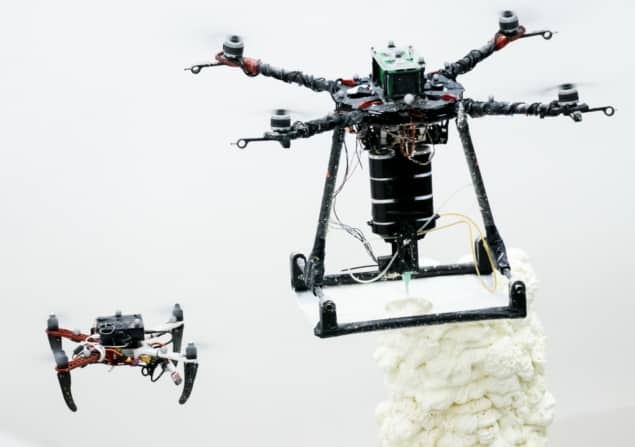Team of flying robots builds structures using 3D printing
09 Oct 2022
On the job: a BuilDrone (right) is shown 3D printing a structure during flight. A ScanDrone (left) is nearby to monitor the building process. (Courtesy: Imperial College London)
Teams of airborne 3D-printing drones could one day be used to complete construction projects in dangerous or hard-to-reach environments – thanks to new technologies developed by researchers led by Mirko Kovac at Imperial College London. The team was inspired by flying animals such as bees, which collaborate to build complex structures.
3D printing is driving a rapid transformation in the construction industry. Using robots to build up structures layer by layer can improve the safety and productivity of building sites. It can also make complex geometrical structures more feasible to build, while reducing material costs and boosting efficiency.
In their study, Kovac’s team looked at how the technique could be taken one step further by combining 3D printing with the latest advances in drone technology. The idea is that unmanned flying vehicles could mimic the behaviour of collaborative builders in nature: including groups of bees, wasps, or termites.
Information gathering
By continually gathering information about the state of a building project, while communicating this data between each other, these creatures can adapt to changing environments to build complex structures across a wide range of size scales.
To mimic these insect builders in a technological system, Kovac and colleagues created four key technologies for unifying the advantages of natural builders with engineering principles. First, they created BuilDrones, which are aerial drones that are adapted to deposit materials to within an accuracy of 5 mm; second, they programmed these drones to use a wireless system to tell other drones what they are doing.
Their third innovation was to use separate ScanDrones to create navigation and task-planning systems. Rather than building themselves, these robots distribute manufacturing tasks between the BuilDrones, assess the quality of their work, and use path-finding algorithms to calculate how these tasks could be completed as efficiently as possible. Finally, Kovac’s team identified lightweight materials that could be easily carried and deposited by the BuilDrones.
Simple building projects
To demonstrate their system, the researchers used a group of drones to carry out a series of simple building projects in the lab: including creating a roughly 2 m-high cylinder, printed from a rapid-curing insulation foam; and making an 18 cm-high cylinder from a lightweight, cement-like material.READ MORE

Throughout these builds, the team showed that their system could readily adapt to variations in robot numbers and print geometry. What is more, just one person was required to supervise the drones’ activities – ensuring that minimal mistakes were made.
Kovac and colleagues now hope that the flexibility of their technology could soon see 3D-printing drones applied in real construction projects. This could be particularly useful for building in hard-to-access, potentially dangerous locations including remote mountain sites and the upper floors of skyscrapers.
The research is described in Nature.
FROM PHYSICSWORLD.COM 20/10/2022

Δεν υπάρχουν σχόλια:
Δημοσίευση σχολίου